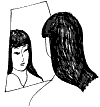TEACHERS (Primary) - Page 5

WRITE
Now write some haiku. You know enough now to get launched. Some suggestions:
» Write about some perception that has stuck in your memory as a vivid picture or a significant moment associated with a particular place.
» Go for a walk and observe the weather, the trees, the birds and anything else. Do it by yourself, with serious attention, taking care to look closely in the spirit of Master Basho. Make notes.
» Look at familiar little things through a magnifying glass: the movement of an insect or worm, earth, wood, the skin of your hand etc.
» Write a haiku structured on two smells, two sounds, or any combination of two sense impressions.
» See if you get an idea about a contrast of big and small, rising and falling, delicate and unyielding etc. Ė but donít try too hard! If it is not based on an observation or experience it will sound contrived.
Donít write about an idea or a thought. Donít use any abstract nouns. Keep it simple and concrete. Stick to accurate observations. You may use seventeen syllables exactly, or, as in many of the examples quoted in this lesson, fewer than seventeen syllables. Have fun!

REFLECT
Now share your haiku with some readers and ask them what they see. If they are confused, or see something quite different to what was in your mind, you need to revise the poem to achieve the effect you seek. If they respond enthusiastically, you have got an early hit!
Teachers
Immediately after discussing the poems provided, set your students to write. In twenty minutes they may well produce three or four new poems. Make sure you leave enough time (five minutes) to share at least one from every student before the end of your teaching session, by reading them aloud.
For Follow-up Lessons do:
» a haiku-walk (known in Japan as a ginko): a rubbish tip can be as good as a beauty spot, but make sure that students are looking closely, touching things, listening and smelling, noting details, thinking of comparisons, looking at the sky as well as the ground and stretching their language.
» re-drafting workshops Ė study the Show Donít Tell lesson on this website for the principles to apply to re-drafting.
» display: Haiku lend themselves very well to visual display work with the younger children, accompanied by drawings or elaborately illuminated initial letters.
» performances: prepare performances for audiences of other classes, parents or other outside groups; haiku need longish pauses between poems; they respond very well to percussion accompaniment, perhaps with the addition of one or two simple haunting notes on a pipe or organ; if you have the skills in drama and dance, they also lend themselves to movement work very effectively.
» work on parts of speech and literary language, especially in relation to translation and style (see follow up in Show Donít Tell).
And click here for more alternative starting points for haiku writing.
CONCLUSION
For advice on organising re-drafting workshops click here.
You have now
» learned what the haiku is and about its special spirit,
» read a number of examples by Japanese masters of the form and some Western ones;
» studied some of the internal structure of poems, made interpretative judgements about them and
» written your first poems.
Congratulations.
LINKS
To see haiku poems written by young children after one introductory lesson like this one, click here.
Michael Gunton, Cicely Hill, James Norton and George Marsh are poets published by the Waning Moon Press. You have read some of their poems. The Basho translations, Koji translations and Dimitar Stefanov translations are by George Marsh (with collaborators) and are also published by Waning Moon. To look at the books, click here.
Downloading the Source Material
The poems have been extracted and are available to download as a Microsoft Word
document.
If this doesn't work, we have also extracted the poems and placed them on a separate web page which can be printed or saved using the 'file' menu.
Press here for the web page
END OF LESSON
Page 1 | Page 2 | Page 3 | Page 4
to the top
|


